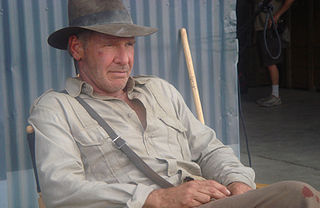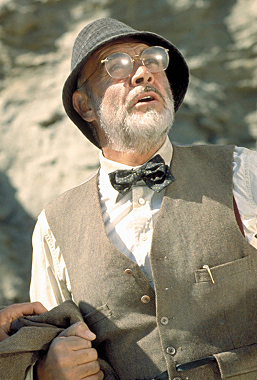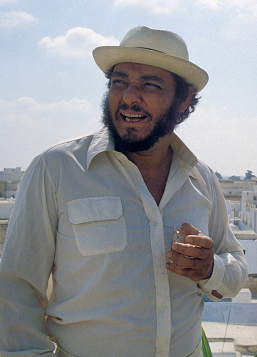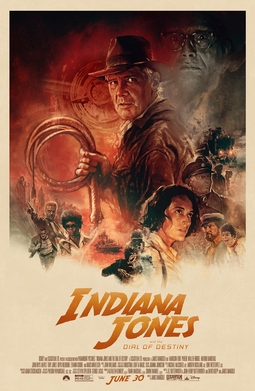
Dr. Henry Walton "Indiana" Jones, Jr., also known simply by the nickname Indy, is the title character and protagonist of the Indiana Jones franchise. George Lucas created the character in homage to the action heroes of 1930s film serials. The character first appeared in the 1981 film Raiders of the Lost Ark, to be followed by Indiana Jones and the Temple of Doom in 1984, Indiana Jones and the Last Crusade in 1989, The Young Indiana Jones Chronicles from 1992 to 1996, Indiana Jones and the Kingdom of the Crystal Skull in 2008, and Indiana Jones and the Dial of Destiny in 2023. The character is also featured in novels, comics, video games, and other media. Jones is also the inspiration for several Disney theme park attractions, including Indiana Jones et le Temple du Péril, the Indiana Jones Adventure, and Epic Stunt Spectacular! attractions.

Indiana Jones and the Last Crusade is a 1989 American action adventure film directed by Steven Spielberg from a screenplay by Jeffrey Boam, based on a story by George Lucas and Menno Meyjes. It is the third installment in the Indiana Jones film series and the follow-up to Indiana Jones and the Temple of Doom (1984), while being a direct sequel to Indiana Jones and the Raiders of the Lost Ark. Harrison Ford returned in the title role, while his father is portrayed by Sean Connery. Other cast members featured include Alison Doody, Denholm Elliott, Julian Glover, River Phoenix, and John Rhys-Davies. In the film, set in 1938, Indiana searches for his father, a Holy Grail scholar, who has been kidnapped and held hostage by the Nazis while on a journey to find the Holy Grail.

Raiders of the Lost Ark is a 1981 American action-adventure film directed by Steven Spielberg from a screenplay by Lawrence Kasdan, based on a story by George Lucas and Philip Kaufman. Set in 1936, the film stars Harrison Ford as Indiana Jones, a globetrotting archaeologist vying with Nazi German forces to recover the long-lost Ark of the Covenant which is said to make an army invincible. Teaming up with his tough former romantic interest Marion Ravenwood, Jones races to stop rival archaeologist Dr. René Belloq from guiding the Nazis to the Ark and its power.

Indiana Jones and the Fate of Atlantis is a point-and-click adventure game developed and published by LucasArts and released in June 1992 for Amiga, DOS, and Macintosh. Almost a year later, it was reissued on CD-ROM as an enhanced "talkie" edition with full voice acting and digitized sound effects. The seventh game to use the script language SCUMM, Fate of Atlantis has the player explore environments and interact with objects and characters by using commands constructed with predetermined verbs. It features three unique paths to select, influencing story development, gameplay and puzzles. The game used an updated SCUMM engine and required a 286-based PC, although it still runs as a real-mode DOS application. The CD talkie version required EMS memory enabled to load the voice data.

The Ahnenerbe was a Schutzstaffel (SS) pseudo-scientific organization which was active in Nazi Germany between 1935 and 1945. It was established by Reichsführer-SS Heinrich Himmler in July 1935 as an SS appendage devoted to the task of promoting the racial doctrines espoused by Adolf Hitler and the Nazi Party. The Ahnenerbe was composed of scholars and scientists from a broad range of academic disciplines and fostered the idea that the German people descended from an Aryan race which was racially superior to other racial groups.

Indiana Jones and the Emperor's Tomb is a 2003 action-adventure video game developed by The Collective and published by LucasArts for the Xbox, Microsoft Windows, PlayStation 2 and OS X. It features cover art by Drew Struzan. The game is an adventure of fictional archeologist Indiana Jones. The story takes place in 1935, acting as a prequel to Indiana Jones and the Temple of Doom. The tomb mentioned in the title is that of China's first Emperor Qin Shi Huang.
Rob Williams is a Welsh comics writer, working mainly for 2000 AD. He is currently writing books for DC Comics and its Vertigo imprint.

Fingerprints of the Gods: The Evidence of Earth's Lost Civilization is a 1995 pseudoarcheology book by British writer Graham Hancock, which contends that an advanced civilization existed in prehistory, one which served as the common progenitor civilization to all subsequent known ancient historical ones. The author proposes that sometime around the end of the last ice age this civilization ended in cataclysm, but passed on to its inheritors profound knowledge of such things as astronomy, architecture and mathematics.

Professor Henry Walton Jones Sr. is a fictional character in the Indiana Jones franchise. He is the Scottish father of Indiana Jones and is a professor of medieval studies at Princeton University. Alongside his academic teachings, Jones Sr. is an author of many books and a professional speaker on his historical subject at many conferences throughout the world. His relationship to his son in the franchise is noted as indifferent due to conflicts on their approaches to their situations, despite the fondness they share for history and archaeology. Much of his life was dedicated to research into the Holy Grail of Christian legend.

Sallah Mohammed Faisel el-Kahir is a fictional character played by Welsh actor John Rhys-Davies in three of the Indiana Jones films: Raiders of the Lost Ark, Indiana Jones and the Last Crusade, and Indiana Jones and the Dial of Destiny. He also appears in various comics and novels, and is featured in the Disney theme park attractions, the Indiana Jones Adventure and The Great Movie Ride.

Nazi archaeology was a field of pseudoarcheology led and encouraged by various Nazi leaders and Ahnenerbe figures, such as Adolf Hitler and Heinrich Himmler, which directed archaeologists and other scholars to search Germany's archeological past in order to find material evidence supporting an advanced, Aryan ancestry as alleged and espoused by the ultranationalist Nazi Party.

The 1938-1939 German Expedition to Tibet, a German scientific expedition, took place between April 1938 and August 1939 under the leadership of the German zoologist and SS-officer Ernst Schäfer.

The Indiana Jones franchise has appeared in many comic books. Marvel Comics initially held the comic book licensing rights before they were acquired by Dark Horse Comics in 1990. Marvel published adaptations of the films Raiders of the Lost Ark, Indiana Jones and the Temple of Doom, and Indiana Jones and the Last Crusade, while Dark Horse adapted the Indiana Jones and the Fate of Atlantis video game, The Young Indiana Jones Chronicles television series, and Indiana Jones and the Kingdom of the Crystal Skull.
Indiana Jones is an American media franchise consisting of five films and a prequel television series, along with games, comics, and tie-in novels, that depicts the adventures of Dr. Henry Walton "Indiana" Jones, Jr., a fictional professor of archaeology.
Lego Indiana Jones is a Lego theme based on the Indiana Jones film franchise created by George Lucas, licensed from Lucasfilm. The exclusive franchise was first announced in June 2007, and followed the successful Lego Star Wars franchise, also with Lucasfilm. The first set of products were launched in 2008, based upon two of the three earlier films. Sets featuring scenes from the fourth film, Indiana Jones and the Kingdom of the Crystal Skull, were released alongside the film, later in 2008. The Temple of Doom film was not featured until 2009, in a large set which re-created the mine-cart chase using new narrow-gauge Lego train track.

Indiana Jones and the Spear of Destiny is a four-issue comic book mini-series published by Dark Horse Comics from April to July 1995. It was their seventh series about the adult Indiana Jones.

The Chachapoyan Fertility Idol, more commonly referred to as the Golden Idol, is a fictitious artifact that appears in the opening sequence of the 1981 film Raiders of the Lost Ark, the first entry in the Indiana Jones franchise created by George Lucas. It is the first relic that the audience sees the protagonist Indiana Jones acquire, establishing him as a treasure hunter. The idol's likeness has become iconic in popular culture.
Since its debut in 1981, the Indiana Jones franchise has become part of American popular culture. References have been made in television series, movies, music and other material since the original film was released.

Indiana Jones and the Dial of Destiny is a 2023 American action adventure film directed by James Mangold, who co-wrote it with Jez Butterworth, John-Henry Butterworth, and David Koepp. It is the sequel to Indiana Jones and the Kingdom of the Crystal Skull (2008), as well as the fifth and final installment in the Indiana Jones film series. Featuring Harrison Ford, John Rhys-Davies, and Karen Allen reprising their roles as Indiana Jones, Sallah, and Marion Ravenwood, respectively, new cast members include Phoebe Waller-Bridge, Antonio Banderas, Toby Jones, Boyd Holbrook, Ethann Isidore, and Mads Mikkelsen. Set in 1969, the film follows Indy and his estranged goddaughter, Helena, who are trying to locate a powerful artifact before Jürgen Voller, a Nazi-turned-NASA scientist who plans to use it to alter the outcome of World War II.















